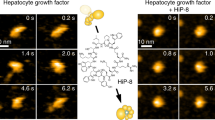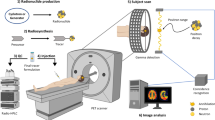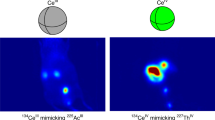Abstract
Improved techniques to noninvasively image protein-protein interactions (PPIs) are essential. We molecularly engineered a positron emission tomography (PET)-based split reporter (herpes simplex virus type 1 thymidine kinase), cleaved between Thr265 and Ala266, and used this in a protein-fragment complementation assay (PCA) to quantify PPIs in mammalian cells and to microPET image them in living mice. An introduced point mutation (V119C) markedly enhanced thymidine kinase complementation in PCAs, on the basis of rapamycin modulation of FKBP12-rapamycin-binding domain (FRB) and FKBP12 (FK506 binding protein), the interaction of hypoxia-inducible factor-1α with the von Hippel-Lindau tumor suppressor, and in an estrogen receptor intramolecular protein folding assay. Applications of this unique split thymidine kinase are potentially far reaching, including, for example, considerably more accurate monitoring of immune and stem cell therapies, allowing for fully quantitative and tomographic PET localization of PPIs in preclinical small- and large-animal models of disease.
This is a preview of subscription content, access via your institution
Access options
Subscribe to this journal
Receive 12 print issues and online access
$209.00 per year
only $17.42 per issue
Buy this article
- Purchase on Springer Link
- Instant access to full article PDF
Prices may be subject to local taxes which are calculated during checkout





Similar content being viewed by others
References
Valdar, W.S. & Thornton, J.M. Protein-protein interfaces: analysis of amino acid conservation in homodimers. Proteins 42, 108–124 (2001).
Shoemaker, B.A. & Panchenko, A.R. Deciphering protein-protein interactions. Part I. Experimental techniques and databases. PLoS Comput. Biol. 3, e42 (2007).
Massoud, T.F. & Gambhir, S.S. Molecular imaging in living subjects: seeing fundamental biological processes in a new light. Genes Dev. 17, 545–580 (2003).
Michnick, S.W. Exploring protein interactions by interaction-induced folding of proteins from complementary peptide fragments. Curr. Opin. Struct. Biol. 11, 472–477 (2001).
Hu, C.D. & Kerppola, T.K. Simultaneous visualization of multiple protein interactions in living cells using multicolor fluorescence complementation analysis. Nat. Biotechnol. 21, 539–545 (2003).
Michnick, S.W., Remy, I., Campbell-Valois, F.X., Vallee-Belisle, A. & Pelletier, J.N. Detection of protein-protein interactions by protein fragment complementation strategies. Methods Enzymol. 328, 208–230 (2000).
Park, K. et al. A split enhanced green fluorescent protein-based reporter in yeast two-hybrid system. Protein J. 26, 107–116 (2007).
Zhang, S., Ma, C. & Chalfie, M. Combinatorial marking of cells and organelles with reconstituted fluorescent proteins. Cell 119, 137–144 (2004).
Paulmurugan, R., Umezawa, Y. & Gambhir, S.S. Noninvasive imaging of protein-protein interactions in living subjects by using reporter protein complementation and reconstitution strategies. Proc. Natl. Acad. Sci. USA 99, 15608–15613 (2002).
Paulmurugan, R. & Gambhir, S.S. Monitoring protein-protein interactions using split synthetic Renilla luciferase protein fragment–assisted complementation. Anal. Chem. 75, 1584–1589 (2003).
Tjuvajev, J.G. et al. Imaging the expression of transfected genes in vivo. Cancer Res. 55, 6126–6132 (1995).
Kang, K.W., Min, J.J., Chen, X. & Gambhir, S.S. Comparison of [14C]FMAU, [3H]FEAU, [14C]FIAU, and [3H]PCV for monitoring reporter gene expression of wild type and mutant herpes simplex virus type 1 thymidine kinase in cell culture. Mol. Imaging Biol. 7, 296–303 (2005).
Iyer, M. et al. 8-[18F]Fluoropenciclovir: an improved reporter probe for imaging HSV1-tk reporter gene expression in vivo using PET. J. Nucl. Med. 42, 96–105 (2001).
Gambhir, S.S. et al. A mutant herpes simplex virus type 1 thymidine kinase reporter gene shows improved sensitivity for imaging reporter gene expression with positron emission tomography. Proc. Natl. Acad. Sci. USA 97, 2785–2790 (2000).
Massoud, T.F. Novel Approaches to Molecular Imaging of Protein-Protein Interactions in Living Subjects. PhD thesis, Univ. Cambridge (2007).
Spotts, J.M., Dolmetsch, R.E. & Greenberg, M.E. Time-lapse imaging of a dynamic phosphorylation-dependent protein-protein interaction in mammalian cells. Proc. Natl. Acad. Sci. USA 99, 15142–15147 (2002).
Chen, J. & Schreiber, S.L. Identification of an 11-kDa FKBP12-rapamycin–binding domain within the 289-kDa FKBP12-rapamycin–associated protein and characterization of a critical serine residue. Proc. Natl. Acad. Sci. USA 92, 4947–4951 (1995).
Remy, I. & Michnick, S.W. Clonal selection and in vivo quantitation of protein interactions with protein-fragment complementation assays. Proc. Natl. Acad. Sci. USA 96, 5394–5399 (1999).
Wurth, C., Thomas, R.M., Folkers, G. & Scapozza, L. Folding and self-assembly of herpes simplex virus type 1 thymidine kinase. J. Mol. Biol. 313, 657–670 (2001).
Jaakkola, P. et al. Targeting HIF-α to the von Hippel-Lindau ubiquitylation complex by O2-regulated prolyl hydroxylation. Science 292, 468–472 (2001).
Paulmurugan, R. & Gambhir, S.S. An intramolecular folding sensor for imaging estrogen receptor-ligand interactions. Proc. Natl. Acad. Sci. USA 103, 15883–15888 (2006).
Peñuelas, I. et al. Positron emission tomography imaging of adenoviral-mediated transgene expression in liver cancer patients. Gastroenterology 128, 1787–1795 (2005).
Brannigan, J.A. & Wilkinson, A.J. Protein engineering 20 years on. Nat. Rev. Mol. Cell Biol. 3, 964–970 (2002).
Chen, R. Enzyme engineering: rational redesign versus directed evolution. Trends Biotechnol. 19, 13–14 (2001).
Massoud, T.F. & Gambhir, S.S. Integrating noninvasive molecular imaging into molecular medicine: an evolving paradigm. Trends Mol. Med. 13, 183–191 (2007).
Michnick, S.W., Ear, P.H., Manderson, E.N., Remy, I. & Stefan, E. Universal strategies in research and drug discovery based on protein-fragment complementation assays. Nat. Rev. Drug Discov. 6, 569–582 (2007).
Qi, J., Leahy, R.M., Cherry, S.R., Chatziioannou, A. & Farquhar, T.H. High-resolution 3D Bayesian image reconstruction using the microPET small-animal scanner. Phys. Med. Biol. 43, 1001–1013 (1998).
Acknowledgements
We thank S. Gobalakrishnan, J. Willmann and O. Gheysens for their assistance with the microPET imaging. T. Massoud was supported in part by US National Cancer Institute In Vivo Cellular and Molecular Imaging Center grant P50 CA86306 and by a Mid-Career Award for Established Practitioners from The Health Foundation, General Electric Medical Systems, the Palgrave Brown Foundation, the Cancer Prevention Research Trust, a Royal College of Radiologists X-Appeal pump priming grant, the Steel Charitable Trust, the Sir Samuel Scott of Yews Trust and the National Institute of Health Research Cambridge Biomedical Research Centre, all in the UK. This work was funded by US National Cancer Institute grant In Vivo Cellular and Molecular Imaging Center P50 CA114747 (S.S.G.) and US National Cancer Institute RO1 CA082214 (S.S.G.).
Author information
Authors and Affiliations
Contributions
All authors designed the experiments. S.S.G. supervised the experiments. T.F.M. and R.P. performed the experiments. T.F.M. and S.S.G. wrote the manuscript. All authors discussed the results and commented on the manuscript.
Corresponding author
Ethics declarations
Competing interests
The authors declare no competing financial interests.
Supplementary information
Supplementary Text and Figures
Supplementary Methods, Supplementary Discussion, Supplementary Figures 1–19 and Supplementary Tables 1 and 2 (PDF 1181 kb)
Rights and permissions
About this article
Cite this article
Massoud, T., Paulmurugan, R. & Gambhir, S. A molecularly engineered split reporter for imaging protein-protein interactions with positron emission tomography. Nat Med 16, 921–926 (2010). https://doi.org/10.1038/nm.2185
Received:
Accepted:
Published:
Issue Date:
DOI: https://doi.org/10.1038/nm.2185
This article is cited by
-
DiB-splits: nature-guided design of a novel fluorescent labeling split system
Scientific Reports (2020)
-
Small near-infrared photochromic protein for photoacoustic multi-contrast imaging and detection of protein interactions in vivo
Nature Communications (2018)
-
Molecular Imaging of CXCL12 Promoter-driven HSV1-TK Reporter Gene Expression
Biotechnology and Bioprocess Engineering (2018)
-
A molecular imaging biosensor detects in vivo protein folding and misfolding
Journal of Molecular Medicine (2016)
-
Small-angle X-ray scattering method to characterize molecular interactions: Proof of concept
Scientific Reports (2015)



